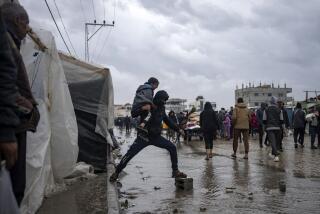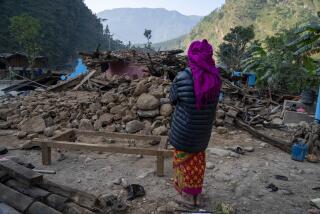Quake Survivors Ponder Next Step
BAM, Iran — By early Tuesday evening, the wintry chill was already clamping down on the devastated landscape. Mostafa Bahramy, 63, dressed in four layers of shirts and a flimsy jacket, faced the prospect of yet another night without a home, in temperatures that promised to dip below freezing.
Bahramy’s lot had improved slightly over the previous night, which he spent huddled next to a sidewalk campfire because he had no place to go. Now he had a tent, but nothing besides his grimy clothes to keep him warm against the pavement beneath.
“No rugs, no blankets, no heater, no fuel,” he said, scowling at the tent amid the gathering darkness.
Bahramy is among the tens of thousands of Bam residents left homeless by Friday’s earthquake, which killed at least 30,000, injured as many as 15,000 more and all but flattened the ancient Iranian city of brittle, brick-and-mud houses.
As hope for finding survivors faded, Iranian television reported late Tuesday that four people had been found alive in the village of Baravot, five miles outside Bam. But with official rescue efforts nearing an end, authorities were facing the problem of what to do with all the people displaced by the quake.
While residents like Bahramy were weighing whether to stay in Bam, many others took to the road, loading pickup trucks with whatever belongings they had salvaged from their broken houses. On Tuesday, the highway to Kerman, the provincial capital 120 miles away, was clogged with earthquake victims going to stay with relatives there. A United Nations official said that relief workers were starting to tally what they would need to cope with a homeless population whose exact size remained unclear.
“The next move has got to be to see how you’re going to manage the medium term and long term, and into the reconstruction,” said Ted Pearn, who manages the on-site U.N. operations-coordination center. So far, there were no immediate health risks, but breaks in sewer lines remained a concern, he said.
The government’s top ministers met in an emergency session Tuesday in Kerman, but they revealed few details about how they planned to deal with the looming humanitarian crisis. But top officials have said Bam would be rebuilt.
Aid has poured in from around the world, including the United States, which sent teams of searchers and supplies. Though Iran and the U.S. have not had diplomatic relations since the seizure of the U.S. Embassy in Tehran in 1979, there was speculation over whether Washington’s offer of aid -- and Iran’s acceptance -- augured a thaw.
Secretary of State Colin L. Powell cited Tehran’s acceptance of the aid, along with its willingness to submit to surprise international inspections of its nuclear program and other recent moves, as signs of a “new attitude” in Iran. In an interview in Tuesday’s Washington Post, he said the U.S. should “keep open the possibility of dialogue at an appropriate point in the future.”
President Mohammad Khatami praised the U.S. help but said Tuesday that “humanitarian issues should not be intertwined with deep and chronic political problems.”
The quake and recovery efforts could also affect Iran’s parliamentary elections, set for February. Even before the quake, a recession and unemployment had left many Iranians unhappy, and once-touted political reforms had come to a standstill, noted Davoud Bavand, a professor of international law in Tehran.
He said the government’s handling of the quake crisis could add another possible source of public dissatisfaction, though it was unlikely to threaten the current government. Iranian media have criticized the government response as slow and charged that a lack of building-safety standards magnified the dangers in a quake-prone nation.
Many of Bam’s homeless say the government’s progress in reconstruction will help them decide whether they will remain in the city.
“Maybe all the people will leave the city. It depends on the government and what they do for the city,” said Ghanabar Afghanizadeh, a 63-year-old retired soldier. He was staying in a donated tent down the street from the mud house that was his home for 30 years.
Among the tent dwellers was Ali Alizadeh, 24, whose pregnant sister died in the quake. Alizadeh and his wife escaped unscathed, but the collapse of his garage wrecked the taxi that was his main source of income. Now he was unsure of what to do or where to go. His wife had already moved in with relatives in Kerman.
Alizadeh said the food and blankets being distributed by soldiers and Red Crescent volunteers helped, but he worried about his long-term prospects in Bam.
“How long can they give food and water? One week. Two weeks. One month,” he said. “What do we do about the future?”
More to Read
Sign up for Essential California
The most important California stories and recommendations in your inbox every morning.
You may occasionally receive promotional content from the Los Angeles Times.










